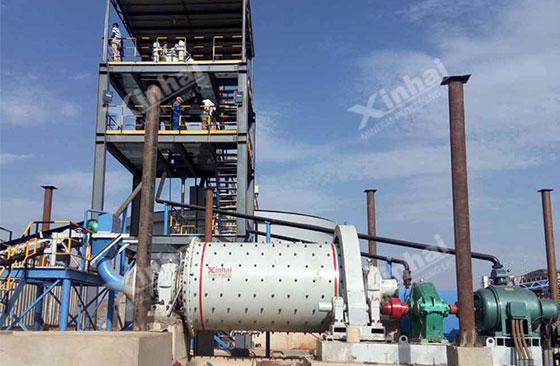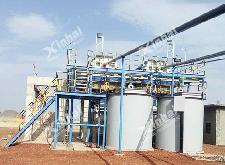

Warm Tip: If you want to know more details about equipment, solutions, etc, please click the button below for free consultation, or leave your requirements!
As is known to all, the dressing operation consists of three stages: pre-dressing, dressing and post-dressing. The preparatory work before mineral dressing generally includes crushing and screening, grinding classification, hand sorting and washing, among which grinding classification is the follow-up technology of crushing and screening and also an important process in the pre-dressing stage. By grinding the ore to a certain degree of fineness, and using classifying equipment to separate the qualified and unqualified products, the whole pre-selection operation is completed. Then, in the production practice, how to choose a reasonable grinding classification process and specific numbers of stage?

The reasonable grinding and classifying process is determined mainly based on the following factors:
Embedded characteristics of useful minerals and gangue minerals;
Hardness and density of useful ores and gangue;
Degree of slime and oxidation of the useful ores and gangue;
Content and value of useful minerals in the raw ore;
Requirements for concentrate particle size in production practice.
2. How to determine the number of stages in the grinding and classifying process?
The number of grinding sections is mainly determined by the size of the concentrator, the grindability of the ore, the grain size of the useful mineral crystals, the grain size of the ore feed and the grain size of the products. In general, when the upper limit of product granularity is greater than 0.15mm, a grinding classification process is adopted. When the upper limit of product granularity is less than 0.15mm, the two-stage grinding classification process is usually adopted.
Under special circumstances, when the ore size is large (the upper limit is more than 25mm), the ore is difficult to grind, the production scale is large, and the product size is coarse, the two-stage grinding grading process can also be considered. If the ore is soft and easy to grind and the production scale is not large, although the upper limit of product particle size is less than 0.15mm, a grinding classification process can also be adopted.
The combination use of ball mill and classifiers constitutes the whole grinding classification process. The number of grinding sections can be determined by technical and economic comparison according to specific conditions. In the production practice, most concentrators usually adopt one-stage or two-stage grinding classification process. The classification process of three and abov is seldom used.
3. What is the commonly used one-stage grinding and classifying process?
The commonly used one-stage grinding and classifying process mainly includes the following three forms:
(1) A closed-circuit grinding process containing only inspection and grading is currently widely used in non-ferrous and ferrous metal concentrators.
(2) A closed-circuit grinding process combining pre-grading and checking grading.
(3) A closed-circuit grinding process with control classification. There are generally two categories. One is the overflow control classification, suitable for one-stage grinding to obtain very fine products, or stage screening, or to use hydrocyclone grading, need to remove the coarse particles in the mechanical classifier; The second is the sand return control classification, the purpose is to reduce the content of qualified products in the sand return, to prevent overgrinding.
4. What are the commonly used two-stage grinding and classifying processes?
The commonly used two-stage grinding and classifying process mainly includes the following three forms:
(1) Two-stage closed-circuit grinding classification process, suitable for dressing plants with large feed size and large production scale.
(2) Two-stage and two-closed-circuit grinding classification process, which is often used in large and medium-sized concentrator whose product size is less than 0.15mm.
(3) The two-stage closed-circuit grinding classification process of stage separation is applicable to the situation where a considerable amount of useful minerals in a section of grinding products have reached monomer dissociation, which can reduce grinding costs and improve metal recovery.
Compared with two-stage grinding and classifying process, the number of graders in a grinding grading process is small and the investment is low. Easy production operation, simple regulation, no transport of intermediate products between sections and sections, multiple series can be placed on the same level, simple equipment configuration, will not affect the work of another section of the mill or classifier shutdown, shutdown loss is small.
Conclusion
To determine the proper grinding and classification process, there are many factors you need to take into consideration, including ore property, operation requirements, production conditions, investment budget and other factors. It is suggested to entrust the qualified concentrator to carry out the experimental research before the construction of the plant, and determine the reasonable grinding classificaiton process according to the scientific test results, so as to achieve greater economic benefits.
Last: What Are The Factors Affecting Gold Leaching?
Next: 3 Important Indicators In Grinding And Classification Stage
1Do You Understand The Grinding And Classifying Process In Mineral Processing Plant?
 0
0
 3726
3726
2Some Questions about Grinding and Classification Stage
 3
3
 4481
4481
34 Types of Crushing Plant
 0
0
 4547
4547


What Are the Differences Between CIP and CIL?
 11383
11383
 0
0